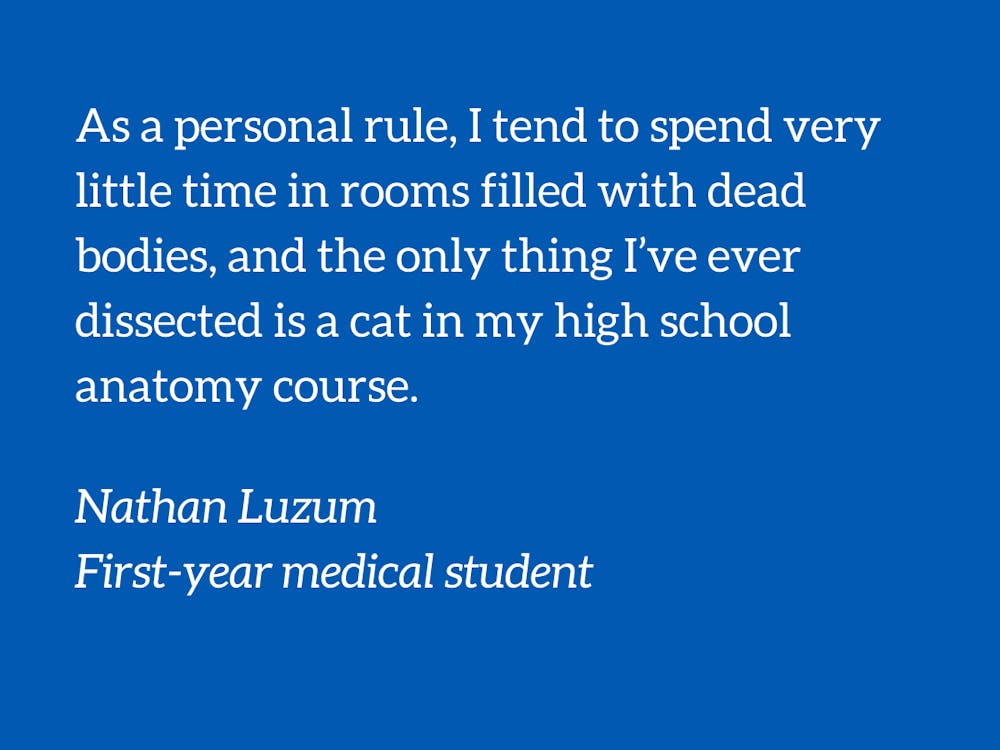One of the time-honored traditions of being a first-year medical student, aside from saturating social media with far too many white coat ceremony photos, is dissecting cadavers in the anatomy lab.
The experience allows students to see the human body as it really is—one big mess of intertwining tubes that’s nowhere near as clear as the textbook. But the journey is just as emotional as it is intellectual. There’s no denying that systematically dissecting a cadaver can seem uncomfortable. As a personal rule, I tend to spend very little time in rooms filled with dead bodies, and the only thing I’ve ever dissected is a cat in my high school anatomy course, so I had no clue what to expect going in.
Part of the unease stems from the setting itself—the anatomy lab, located in the deep recesses of Duke’s maze of a hospital, always seems a tad too cold. Two dozen or so blue bags, encasing the cadavers, adorn tables scattered along the walls of the room. The smell of formaldehyde hangs in the air and seeps into your scrubs, providing a constant reminder that they need to be washed. Rumor has it that this preservative odor also stimulates hunger, and I can attest to feeling ready for dinner at 3 p.m. on anatomy days. As you might imagine, this can be awkward, especially if your stomach starts growling while you’re cutting into a huge layer of muscle. But there isn’t much hard-and-fast evidence to back up the hunger hypothesis as far as I can tell, so I probably just need to bring a bigger lunch instead of throwing a bunch of random stuff in a bowl and microwaving it.
The room and its associated smells are just the beginning of the anatomy experience. Even more onerous was contending with the idea that we were dissecting a person, someone with a story, a family, a life that had been lived and was now complete. These thoughts became more intrusive when my group unzipped the bag for the first time and unwrapped an underlying sheet, revealing the cadaver. I took the scalpel and made my group’s first cut, penetrating the characteristic leathery skin and fascia of the upper back to reveal muscle beneath. The die was cast.
There seem to be two general schools of thought around dissecting cadavers. One perspective holds that they represent our first patients, while the other considers them to be dead bodies and nothing more. At first, I was partial to the latter, simply because it created less cognitive dissonance. Treating cadavers as inanimate teaching tools removes the emotional heft of realizing that you’re cutting into a person, someone who had values and hobbies and everything else that makes up an identity. But I’ve found this framework constantly challenged.
For each cadaver, groups receive a small index card with information from the donor’s family. The card contains mostly medical information, including cause of death, other past diagnoses and surgical history. However, there are a few lines that encapsulate a life’s worth of social history: snippets about family, occupation, hobbies. They’re hints that this body was once a person.
Although we spend most of our time dissecting, peeling away layers of muscle and analyzing even more muscle that lies beneath, we also learn to perform a few procedures. First up was a mock lumbar puncture, where we inserted a long needle between two vertebrae on our cadaver’s lower back. Later, we broke out hammers and chisels to perform a procedure called a laminectomy where the back half of the vertebrae is removed to relieve pressure on a constricted spinal cord. In these moments, the cadaver seemed less like a body and more like a patient.
And as I strolled around the room, observing my classmates hovering over their cadavers, I realized that this core question of person versus body is at the crux of a physician’s practice. It’s easy to lose sight of individuality and see patients as numbers, lists of medical conditions, tests ordered and measurements taken—an approach that might seem simpler, but is far too reductive. The challenge for physicians is to everlastingly look for those elements that turn bodies into people, to hunt out the most important aspects of someone’s identity. Sure, that’s easier when the person is alive, but the same principle can be applied to dissecting cadavers.
From an outsider’s perspective, anatomy lab might seem like a bunch of clueless students slicing up a body, pointing at various slimy fibers and asking instructors “What’s that?” for a few hours until everyone’s tired and hungry and ready to go. But after only a couple weeks, I’ve come to see anatomy lab as a far more meaningful experience—a lesson to look beyond a body and see a human being.
Nathan Luzum is a first-year medical student. His column runs on alternate Thursdays.
Get The Chronicle straight to your inbox
Signup for our weekly newsletter. Cancel at any time.

